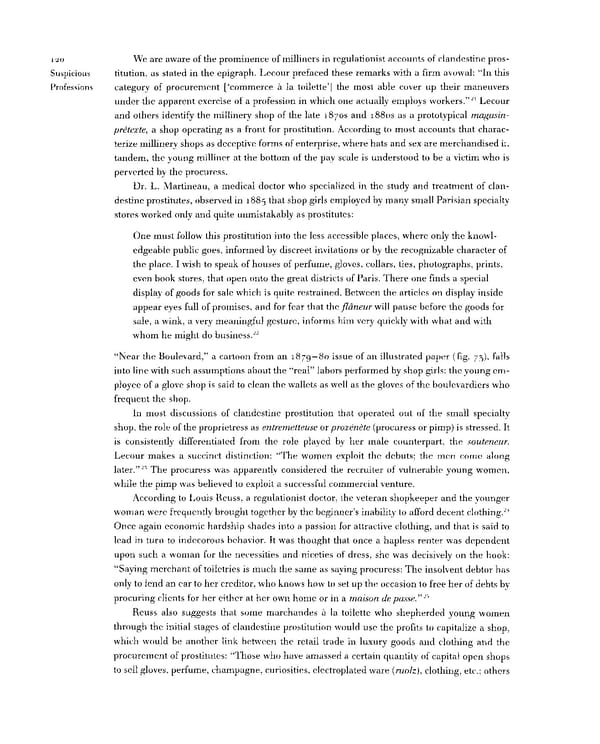120 We are aware of the prominence of milliners in regulationist accounts of clandestine pros- Suspicious titution, as stated in the epigraph. Lecour prefaced these remarks with a firm avowal: "In this Professions category of procurement ['commerce a la toilette'] the most able cover up their maneuvers under the apparent exercise of a profession in which one actually employs workers."21 Lecour and others identify the millinery shop of the late 18705 and i88os as a prototypical magasin- pretexte, a shop operating as a front for prostitution. According to most accounts that charac- terize millinery shops as deceptive forms of enterprise, where hats and sex are merchandised h. tandem, the young milliner at the bottom of the pay scale is understood to be a victim who is perverted by the procuress. Dr. L. Martineau, a medical doctor who specialized in the study and treatment of clan- destine prostitutes, observed in 1885 that shop girls employed by many small Parisian specialty stores worked only and quite unmistakably as prostitutes: One must follow this prostitution into the less accessible places, where only the knowl- edgeable public goes, informed by discreet invitations or by the recognizable character of the place. I wish to speak of houses of perfume, gloves, collars, ties, photographs, prints, even book stores, that open onto the great districts of Paris. There one finds a special display of goods for sale which is quite restrained. Between the articles on display inside appear eyes full of promises, and for fear that the flaneur will pause before the goods for sale, a wink, a very meaningful gesture, informs him very quickly with what and with whom he might do business.22 "Near the Boulevard," a cartoon from an 1879 — 80 issue of an illustrated paper (fig. 73), falls into line with such assumptions about the "real" labors performed by shop girls: the young em- ployee of a glove shop is said to clean the wallets as well as the gloves of the boulevardiers who frequent the shop. In most discussions of clandestine prostitution that operated out of the small specialty shop, the role of the proprietress as entremetteuse or proxenete (procuress or pimp) is stressed. It is consistently differentiated from the role played by her male counterpart, the souteneur. Lecour makes a succinct distinction: "The women exploit the debuts; the men come along later."23 The procuress was apparently considered the recruiter of vulnerable young women, while the pimp was believed to exploit a successful commercial venture. According to Louis Reuss, a regulationist doctor, the veteran shopkeeper and the younger woman were frequently brought together by the beginner's inability to afford decent clothing.24 Once again economic hardship shades into a passion for attractive clothing, and that is said to lead in turn to indecorous behavior. It was thought that once a hapless renter was dependent upon such a woman for the necessities and niceties of dress, she was decisively on the hook: "Saying merchant of toiletries is much the same as saying procuress: The insolvent debtor has only to lend an ear to her creditor, who knows how to set up the occasion to free her of debts by 25 procuring clients for her either at her own home or in a maison depasse." Reuss also suggests that some marchandes a la toilette who shepherded young women through the initial stages of clandestine prostitution would use the profits to capitalize a shop, which would be another link between the retail trade in luxury goods and clothing arid the procurement of prostitutes: "Those who have amassed a certain quantity of capital open shops to sell gloves, perfume, champagne, curiosities, electroplated ware (ruolz), clothing, etc.; others
 Prostitution & Impressionists Page 140 Page 142
Prostitution & Impressionists Page 140 Page 142